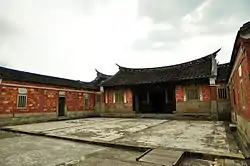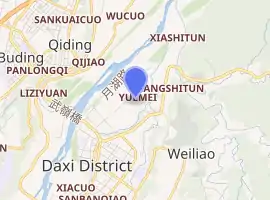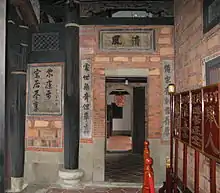Lee Teng-fan's Ancient Residence
The Lee Teng-fan's Ancient Residence (Chinese: 李騰芳古宅; pinyin: Lǐ Téngfāng Gǔzhái) is a former residence in Yuemei Village, Daxi District, Taoyuan City, Taiwan.[1] The residence is part of Daxi Wood Art Ecomuseum.[2]
| Lee Teng-fan's Ancient Residence | |
|---|---|
李騰芳古宅 | |
 | |

| |
| General information | |
| Type | Former residence |
| Location | Daxi, Taoyuan City, Taiwan |
| Coordinates | 24°53′26.6″N 121°17′42.6″E |
| Opened | 1859 |
History
The residence building was built in 1859 after Teng-fan was recommended to Emperor Sien-feng by the local government. It was later on designed as a Grade 2 historic building by Taoyuan County Government. It was opened to the public in 2004.[3]
Architecture

The Hakka-style residence consists of two main buildings and four side buildings, guarded by a large semi-circular pool and a whitewashed wall of mud brick. The living and reception rooms are located at the center area. The side buildings on both sides guard the open courtyard with two stone bases. The roof of the center main hall is taller than the other portions. The reception area is the major entrance to the building. The main gate is placed slightly behind its ordinary position. The side buildings are the living quarters. Rooms were assigned to family members according to their seniority.[4][5]
The residence buildings are decorated with woodcarvings. All of them are of the patterns of flowers, birds and animals. There are also many pieces of calligraphy and paintings inside the building.
References
- "Archived copy". Archived from the original on 2014-12-31. Retrieved 2014-12-31.CS1 maint: archived copy as title (link)
- Liao, George (18 July 2018). "Neat places to visit in Daxi in Taiwan's northern city of Taoyuan". Taiwan News. Retrieved 20 July 2018.
- "Li Teng-fang House -- One of the finest surviving examples of a Hakka residence in Taiwan". China Post. Retrieved 2017-08-20.
- "Lee Teng-fan's Ancient Residence". Taoyuan Tourism. Archived from the original on 2018-03-02.
- "李騰芳古宅(李舉人古厝)". 桃園古蹟建築.
| Wikimedia Commons has media related to Li Teng-Fang Historical Home, Taoyuan. |